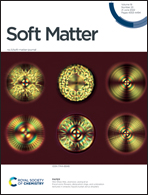Hydrogel composite mimics biological tissues
Abstract
A novel composite hydrogel was developed that shows remarkable similarities to load bearing biological tissues. The composite gel consisting of a poly(vinyl alcohol (PVA) matrix filled with poly(acrylic acid) (PAA) microgel particles exhibits osmotic and mechanical properties that are qualitatively different from regular gels. In the PVA/PAA system the swollen PAA particles “inflate” the PVA network. The swelling of the PAA is limited by the tensile stress Pel developing in the PVA matrix. Pel increases with increasing swelling degree, which is opposite to the decrease of the elastic pressure observed in regular gels. The maximum tensile stress Pmaxel can be identified as a quantity that defines the load bearing ability of the composite gel. Systematic osmotic swelling pressure measurements have been made on PVA/PAA gels to determine the effects of PVA stiffness, PAA crosslink density, and Ca2+ ion concentration on Pmaxel. It is found that Pmaxel increases with the stiffness of the PVA matrix, and decreases with (i) increasing crosslink density of the PAA and (ii) increasing Ca2+ ion concentration. Small angle neutron scattering (SANS) measurements indicate only a weak interaction between the PVA and PAA gels. It is demonstrated that the osmotic swelling pressure of PVA/PAA composite gels reproduces the osmotic behavior of healthy and osteoarthritic cartilage.



 Please wait while we load your content...
Please wait while we load your content...